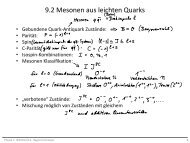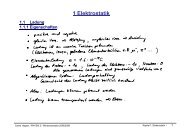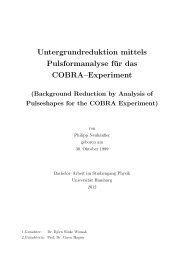Setup of a Drift Tube Muon Tracker and Calibration of Muon ...
Setup of a Drift Tube Muon Tracker and Calibration of Muon ...
Setup of a Drift Tube Muon Tracker and Calibration of Muon ...
Create successful ePaper yourself
Turn your PDF publications into a flip-book with our unique Google optimized e-Paper software.
with ∆⃗q = ⃗q n − ⃗q n−1 . ∆⃗q can be derived from Eq. 3.9 as:∆⃗q = ( J T V −1 J ) ( −1J T V −1 (⃗r − d(⃗q ⃗ )n−1 )) .The Hesse parameters α <strong>and</strong> p from the pattern recognition are used as start parameters⃗q 0 . Once the ∆χ 2 between two iterations drops below a certain limit, thefit is stopped. The error <strong>of</strong> the track parameters can be derived from the covariancematrix C which is given by [66]:C(⃗q) = ( J T V −1 J ) −1.After the fit was successful, a test is performed whether the residuals <strong>of</strong> all hitsare below 3σ. Any hit exceeding this constraint is removed from the hit list <strong>and</strong> thefit procedure is redone. If less than 4 hits remain, the fit is aborted.3.5.7 3D infoFor each 2D-plane P i , the track is reconstructed <strong>and</strong> its parameters in the planesreference system (ξ i ,ζ i ) are given in the Hesse Form:ξ i cos α i + ζ i sinα i − p i = 0. (3.10)To obtain 3D track information, one has to transform this to the global referencesystem:p 1 −z sin α 1cos α 1zxcos α 0 + z sin α 0 − p 0 = 0 (3.11)y cos α 1 + z sin α 1 − p 1 = 0. (3.12)Each point <strong>of</strong> the track can thus be expressed in dependence <strong>of</strong> z as:⎛ ⎞p 0 −z sin α 0⎛ p 0⎞ ⎛ ⎞cos α⎜ 0 cos α⎟ 0− tan α 0⎝ ⎠ = ⎝ p 1 ⎠ + z ⎝− tan α 1⎠ (3.13)1cos α 10It is assumed that all muons come from above, that is traveling in the (−z)-direction.A direction vector d ⃗ can thus be expressed as⎛ ⎞tan α 0⃗d = ⎝tan α 1⎠. (3.14)−1To obtain the polar angle θ, one can use the following correlation:⃗d · (−⃗z) = | ⃗ d| · |⃗z| · cos θ (3.15)where ⃗z is any vector pointing in z-direction. This leads toz = √ tan 2 α 0 + tan 2 α 1 + 1 · z · cos θ (3.16)()θ = cos −1 1√ . (3.17)tan 2 α 0 + tan 2 α 1 + 140





